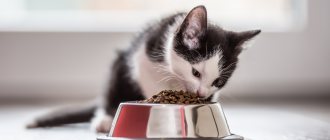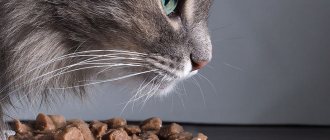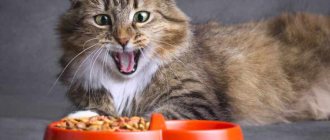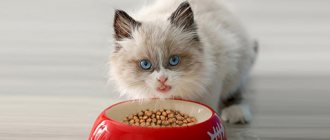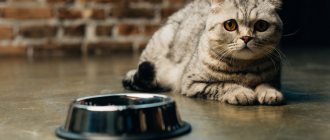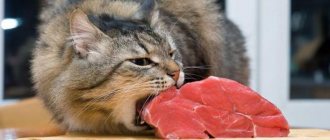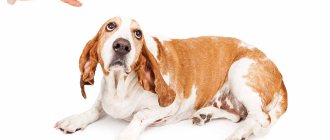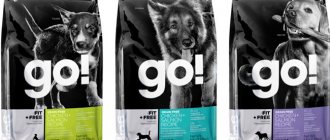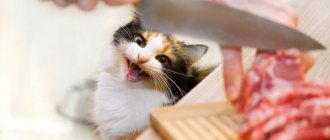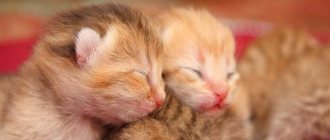Is it possible to feed a cat dry and wet food at the same time?
When ready-made food first appeared on store shelves, there was a widespread myth among cat owners that in order to digest dry and wet food options, different enzymes are produced in the pet’s stomach, so mixing them is strictly prohibited.
As studies conducted by various companies have shown, there is no fundamental difference in the synthesis of digestive juices, so the idea has not been confirmed. Today, experienced breeders and veterinarians do not rule out feeding “crackers” and pates at the same time.
Should you mix dry and wet food?
There is no definite answer to the question; it depends on the wishes of the animal owner and the taste preferences of the cat. It is allowed to separate dry and wet food by pouring both into a bowl at the same time.
The last option is impractical:
- The cat most often likes one of the offered products more, he eats it first, and the second part remains untouched.
- Upon contact with the contents of the pouch, the crunchy granules become soggy and lose their attractiveness to the cat.
- If canned food remains in the bowl, it will become airy and may turn sour in hot weather and cause poisoning or indigestion.
Therefore, most owners who have chosen a mixed feeding principle prefer to give different foods at separate meals.
Hydrates your cat
Cats are not particularly good at drinking water. Some will ignore the water bowl. Others tend to hang around the bowl and don't actually drink anything. Others will only drink from a dripping bathroom faucet or from dirty puddles.
The easiest way to make sure your cat gets all the water it needs is to feed it wet food. It can contain anywhere from 10% to 30% moisture, while most dry foods contain significantly less.
© shutterstock
Is it possible to feed a cat only dry food?
On a high-quality option, selected taking into account gender, breed, age, lifestyle, and special needs, a cat can live a long life. The animal should have the opportunity to eat often, but little by little. This method is physiological for the animal. They can feed themselves up to 15-20 times per day.
Smell will be the cat's priority when choosing food; taste comes second. Animals' sense of smell is more developed than the sensitivity of their receptors.
Cats have well-developed associative memory. It is impossible to combine the introduction of a new food with a stressful moment. When moving, when a child or a new pet appears in the house, or during illness, food is left unchanged.
Dry food provides the necessary stress for predators on the jaw muscles and gums, removes plaque, and helps prevent diseases (allergies, urolithiasis). Only in some periods of life will drying have to be replaced with a wet option. For example, older animals and kittens find it difficult to chew pellets.
Feeding standards
All packages of ready-made food indicate the dosage of the daily portion in grams, depending on the age and weight of the animal.
The amount of wet food is considered normal at a value of 5% of the animal’s weight. That is, if a pet weighs 5 kg, then 175 g of wet food per day is enough for him.
Note! A cat with a calm lifestyle needs 70 ml of water per 1 kg of weight per day, and with an active lifestyle - 85 ml per 1 kg of weight. This is approximately 4-6 tbsp. spoons of water.
For adult cats, the daily intake of dry food is:
- weight up to 3 kg - 25 g;
- weight from 3 to 4 kg - 40 g;
- weight from 4 to 5 kg - 55 g;
- weight over 5 kg - 12 g per 1 kg of weight.
For a kitten this norm looks like this:
- weight up to 2 kg - 35 g;
- weight from 2 to 3 kg - 50 g;
- weight from 3 to 4 kg - 70 g.
A pregnant cat needs 55 g of dry food per day.
For large breed cats, the calculation is based on the rule: 12 g per 1 kg of animal weight.
For older animals, the norm is slightly reduced by 10-20%.
For active cats, the feeding schedule is free in large portions.
For sterilized cats, food is given 2 times a day in small portions, as they are prone to obesity.
Feeding standards for cats should be followed
Is it possible to soak dry food?
Soaking food helps to feed an animal accustomed to wet spiders, preferring a certain type of “crackers”, but not having the opportunity to eat them in their original form (trauma to the gums, jaw, loss of teeth, etc.). Warm water is added to the granules; in 15-20 minutes the food will soften, absorbing moisture.
It will not reach the state of puree; to force-feed the cat with a syringe, you will have to grind it with a blender. Fresh food with the addition of water does not lose its nutritional qualities, animals like it, and it is not worth storing it in the refrigerator for more than 12 hours. Such food is a breeding ground for bacteria.
Be sure to read:
Is it possible to feed a cat dry food and natural food at the same time: pros and cons, which is better?
General information about feed
Industrial cat food is becoming increasingly popular and there are many reasons for this. The food does not need to be prepared, just pour it into a bowl - it’s convenient and saves time. Good food contains an optimal balance of nutrients, vitamins and microelements. Composing a complete diet, especially for a picky pet, is a difficult task, but food solves this problem.
Many owners find the convenience of storage a plus, because natural products quickly deteriorate, and drying, subject to certain conditions, can be purchased several months in advance. Only dry food is suitable for using an automatic feeder, since natural food should only be served fresh and warm. Dry food is easy to dose, and by pouring a certain amount of granules into a bowl, you can be sure that your cat will get everything she needs. Enough positives, don't you agree?
Where there are pros, there are also cons. Feed is usually divided into classes:
- Economy is a useless or even harmful product for cats. The basis for this food is beans or soybeans, and the meat is the remains of carcasses - hooves, bones, skin, fat. There is no talk about vitamins and microelements. Economy food is a useless stomach filler that the cat will not benefit from.
- Premium and super-premium are everyday foods, which, logically, should be fully balanced and fortified. By the way, not every food of these classes meets the declared characteristics, but we’ll talk about this below.
- Holistic is the highest class of food, as close as possible to the natural composition. Manufacturers guarantee that the ingredients of holistic food are grown in the best conditions and do not contain additives, hormones, antibiotics, dyes, flavor enhancers and preservatives.
- Medicinal – food for animals with chronic health problems. It is important to understand that medicated food cannot be given to a cat for prevention, since it will most likely cause her to get sick.
Further, feeds differ in consistency:
- Dry or dry food - compressed granules with a minimum amount of water. Once in the stomach, the granules absorb a lot of liquid, so it is important to ensure that the cat always has water.
- Semi-moist food or kibbles with gravy are a more appetizing looking and smelling treat. Semi-moist food has a short shelf life.
- Pate is the same semi-moist food, but highly crushed. Feeding pate is not relevant unless we are talking about a kitten and the cat has healthy teeth. It is important to understand that the teeth will remain healthy as long as the cat uses them, that is, chews food.
- Treats – vitamins, hygiene sticks and dried meat. These products are used for rewards, disease prevention and dental problems.
The choice is rich and it’s difficult not to get lost in it. An unambiguous recommendation is only one natural one is better than economy feed. It is worth understanding that you will not be able to save money by putting your pet on cheap food; more precisely, your savings will quickly turn into substantial bills for your pet’s treatment. Natural feeding of a cat is not as complicated a science as it seems. Yes, there are nuances, it takes time, knowledge... but aren’t these sacrifices worth the health and longevity of the pet?
Note! If you cannot determine for yourself what is healthier, natural food or industrial food, watch advertising for drying. All manufacturers, as one, chant: “from natural products”...the conclusions are obvious, aren’t they?
Trust but check
Always read the fine print, even when choosing food. Do not trust advertising and labels placed on food. You'll always see a happy cat and bright letters on the front of the package, but you should be interested in what's written on the back.
The composition should be understandable to a “mere mortal”. All ingredients must be clearly stated, for example, veal, not a mixture of meat. The composition is always compiled in descending order , that is, meat should come first on the list, not grains or vegetables. The composition must contain the full range of additives and preservatives. Please note that products with a long shelf life may not contain preservatives.
The next important point is the integrity of the pack. Refrain from purchasing food in bulk or make sure you are dealing with a reputable seller. Once opened, dry food oxidizes within a few months, making it useless and even harmful to the cat. To sell leftovers, dishonest sellers often mix stale or expired food with granules from a fresh bag. Please note that when sold by weight, feed should be stored in closed food-grade plastic containers and not in bags.
When do you need to change the type or diet of feeding?
When the food suits your pet and does not cause allergies, there is no need to change it. It happens that a cat refuses to eat for a day or two, this is normal if there are no signs of illness: vomiting, fever, diarrhea. This is how the animal cleans itself.
During this period, you can offer him a different diet option; perhaps pate or pieces in jelly instead of the usual dry food will stimulate his appetite. You can change the type of food during the rehabilitation period after an illness, when a cat is feeding kittens, injuries, diseases that prevent you from chewing hard lumps.
Pets that constantly consume soft food may suffer from tartar, periodontal disease, insufficient load on the chewing muscles; predators are supposed to chew and tear. It is still advisable to alternate between foods of different consistency. The food should be changed in case of hair loss, redness of the ears and other manifestations of intolerance or allergies.
Pros and cons of mixed cat nutrition
If you follow the above recommendations, monitor the daily calorie intake and buy high-quality food of high nutritional value for the animal, then mixed nutrition has no disadvantages.
On the contrary, cats love variety. You cannot use diets with a high content of plant components, fat, vegetables, corn derivatives, wheat: Kitikat, Friskas, Whiskas.
Many owners successfully use the method of feeding cats with wet and dry food. This type of food has no contraindications if the animal consumes both options with equal pleasure. Veterinarians believe that canned food is useful during hot periods, as it provides the body with moisture. You just need to monitor the norm and freshness of the contents of the bowl. Do you practice mixed feeding or do you prefer one type of food?
Benefits of mixed feeding for dogs
Before switching a dog to dry food alternating with wet canned food, any owner wants to know the benefits of such a decision. Waltham® Research Center specialists name the main ones:
- Maintains optimal water balance in the pet's body.
- Complete enrichment of the pet with energy components and nutrients.
- The animal's innate instinct in searching for a variety of food products is realized. The risk of developing neophobia is reduced.
- Cases of urolithiasis are reported less frequently as daily water consumption increases.
- Reduces the risk of dental problems as the dry granules remove plaque from teeth.
- Balanced diets prevent obesity.
The final conclusions of English scientists were supported by veterinarians from different countries. The published information became the basis for a number of seminars on diseases of the gastrointestinal tract, kidneys, and urinary system at international veterinary symposiums.
Important: Testing was carried out using premium products from leading brands. Low quality products do not provide animals with balanced nutrition.
